Overview
The article titled "How to Design a Website: A Step-by-Step Guide to Effective Web Design" focuses on providing a systematic approach to creating effective websites. It outlines essential principles such as visual hierarchy, consistency, and responsive design, and offers a comprehensive step-by-step guide that includes defining goals, researching the audience, and optimizing for SEO, thereby emphasizing the importance of thoughtful planning and execution in web design to enhance user experience and achieve business objectives.
Introduction
In the digital age, an effective website is not merely a collection of pages but a strategic tool that shapes user experience and drives business success. The principles of web design are foundational to this endeavor, encompassing essential elements such as:
- Visual hierarchy
- Consistency
- Responsive design
By adhering to these principles, organizations can create engaging platforms that not only attract visitors but also retain them. This article delves into the fundamentals of effective web design, outlining step-by-step strategies for crafting a user-centric website while exploring the critical role of content and current trends that are shaping the future of online experiences.
As the web design landscape continues to evolve, understanding these key components becomes increasingly vital for businesses aiming to thrive in a competitive environment.
Fundamentals of Effective Web Design
is supported by several fundamental principles that are essential for understanding how websites are designed to attract and retain visitors.
-
: This principle involves arranging elements in a way that directs attention towards the most critical information first.
By manipulating size, color, and spacing, designers can create a clear structure that enhances comprehension and engagement. Recent studies indicate that individuals will , underscoring the need for effective visual hierarchy from the outset.
-
Consistency: A uniform design across all pages, including consistent fonts, colors, and button styles, fosters familiarity and trust among visitors. Consistency not only strengthens brand identity but also guarantees that visitors can navigate your site intuitively.
-
Responsive Design: In an era where approximately 40% of individuals will switch to another search result if a site is not mobile-friendly, it is critical to emphasize that —desktops, tablets, and smartphones—is non-negotiable for retaining visitors.
-
Accessibility: is crucial, as it allows everyone, including those with disabilities, to navigate your site effectively.
Incorporating accessibility features not only broadens your audience but also improves satisfaction among individuals.
-
: significantly enhance experience and reduce bounce rates.
Techniques such as optimizing images and minimizing code are essential for improving performance and ensuring that individuals remain engaged with your content.
A notable example of the impact of these principles can be seen in the Orah homepage optimization project. By focusing on simplifying navigation and enhancing the visibility of testimonials, Orah achieved a remarkable 63.27% increase in demo request clicks.
This outcome emphasizes the significance of visual hierarchy in directing attention effectively. As the market for web creation reached $42.2 billion in 2023, with a compound annual growth rate (CAGR) of 2.6%, the necessity for tech startups to understand how websites are designed according to these web creation principles becomes increasingly apparent in a competitive landscape.
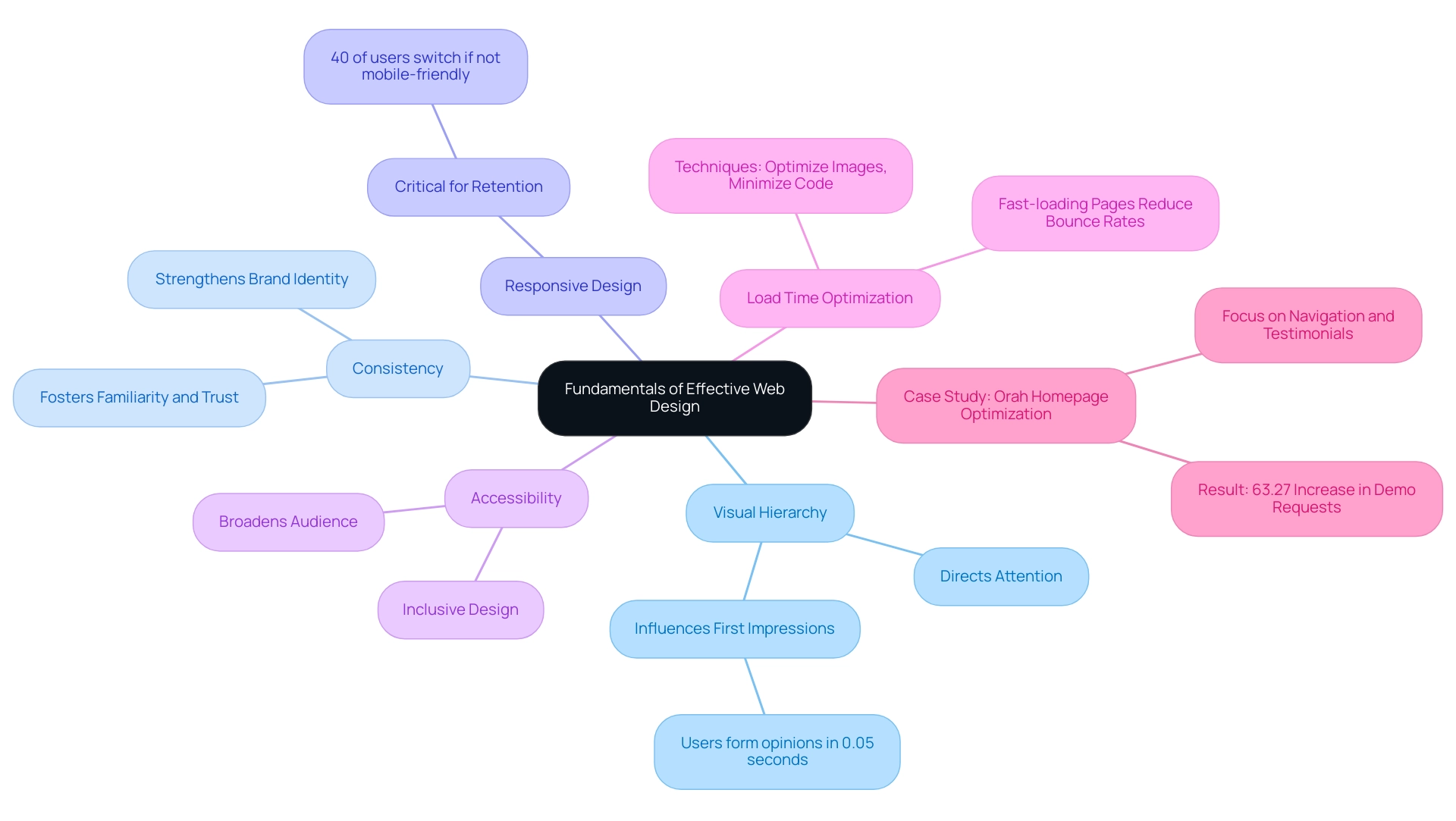
Step-by-Step Strategies for Designing Your Website
Creating an effective online platform requires a systematic approach to understand , ensuring it meets and achieves business objectives. Here is a comprehensive to streamline your web design process:
-
Define Your Goals: Establish clear objectives for your online platform.
Identify whether your focus is on generating leads, selling products, or disseminating information. This foundational step informs how websites are designed and influences every subsequent decision. -
Research Your Audience: Gain a thorough understanding of your target audience.
Utilize surveys, analytics, and audience research methods to gather insights into user preferences and behaviors. As noted by IT professional Matt Loy,His strategic approach and diverse expertise in business and technology enable him to deliver innovative solutions and tangible results in demanding situations.
This highlights the significance of aligning creative strategies with audience expectations and customizing your platform to fulfill their needs. -
Create a Sitemap: Develop a detailed sitemap that outlines the structure of your online presence.
This visual representation of how websites are designed, including all pages and their hierarchy, will serve as a roadmap for your creation process, ensuring a logical flow of content. -
Wireframe Your Design: Produce a wireframe to sketch the basic layout of your website.
Focus on the positioning of , footers, and navigation to understand how websites are designed. This initial layout phase allows you to experiment with various arrangements, showcasing how websites are designed before finalizing a choice. -
Choose a Creation Tool or Platform: Select an appropriate creation platform or tool that aligns with your skills and project requirements.
Options like WordPress and Wix for platforms, or Adobe XD and Figma for creation tools, offer varying levels of customization and usability. -
Design and Develop: Begin the design process, integrating branding elements to create a cohesive identity.
Concentrate on how websites are designed to enhance usability features, thereby improving the individual's interaction and ensuring that navigation is intuitive and engaging. -
Optimize for SEO: Implement current , including strategic keyword integration, the use of meta tags, and alt text for images.
Additionally, leverage tools like Google PageSpeed Insights to analyze how websites are designed for performance and ensure your site loads quickly, which is crucial for retaining visitors and improving search engine rankings. -
Test and Launch: Conduct thorough testing across various devices and browsers to ensure compatibility and functionality.
Employee performance analysis tools like Google PageSpeed Insights and GTmetrix at this stage to pinpoint any problems that may impact visitors. Resolve any issues related to how websites are designed prior to launching your platform to ensure a seamless interaction from the beginning.
With around , investing in a well-crafted site is essential. Notably, 73% of businesses recognize the in differentiating themselves from competitors, demonstrating the direct correlation between website design and customer engagement.
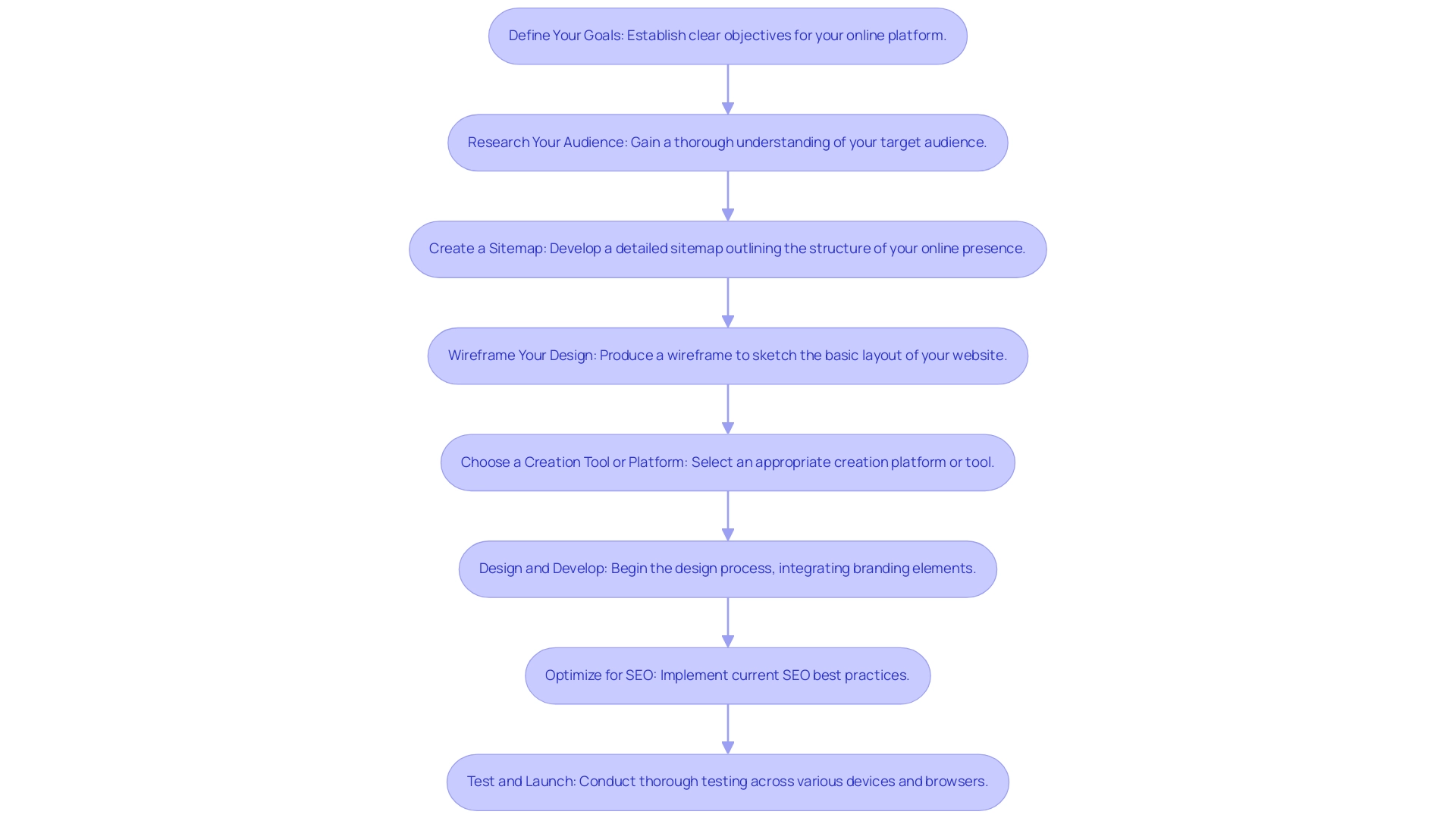
Enhancing User Experience Through Thoughtful Design
To enhance the experience effectively, tech startup founders should prioritize the following strategies, reflecting RNO1's :
- : A well-structured navigation menu is crucial for enabling individuals to find what they need quickly. Employ descriptive labels for menu items to guide visitors seamlessly through your site. Research indicates that a , which directly affects their ongoing engagement. It takes less than 500 milliseconds to make a good first impression, underscoring the importance of intuitive navigation.
- Visual Consistency: Maintaining uniformity in design elements—such as buttons, fonts, and color schemes—is essential. Inconsistent visuals can lead to confusion, detracting from the overall interaction. A study indicates that 88% of individuals are less likely to revisit an online platform after facing inadequate interaction, emphasizing the essential nature of consistency. Furthermore, to distinguish themselves from rivals, acknowledging the significance of aesthetics in customer retention.
- : High-quality images and videos not only capture attention but also effectively convey information. Ensure that these visuals are relevant and enhance the text, creating a more engaging interaction for individuals, and support a design-focused approach that aligns with branding objectives.
- : With a growing number of individuals accessing websites via mobile devices, it is imperative that your site is fully responsive. This involves enhancing touch interactions and layout modifications to guarantee a smooth interaction. Current best practices in web design emphasize mobile optimization to meet client expectations, furthering RNO1's commitment to enhancing satisfaction across platforms.
- : Incorporating elements that facilitate feedback—such as contact forms or surveys—can provide valuable insights into experience. Comprehending perspectives can assist in recognizing areas requiring enhancement. As noted by Capgemini, 70% of consumers now prefer interacting with conversational assistants for quicker interactions, reinforcing the importance of engagement strategies that align with design-driven solutions.
- Accessibility Features: Implementing accessibility features, such as descriptive alt text for images and keyboard navigation, is vital for ensuring that all individuals can engage with your content. This not only broadens your audience but also aligns with best practices in inclusive approaches, reflecting RNO1's commitment to user-centric solutions and in online interactions.
- Create for Privacy and Security: Incorporating choices that enhance individual privacy—such as —can significantly influence trust. Clear communication regarding how data is collected and utilized not only aligns with best practices in data security but also reinforces RNO1’s commitment to protecting sensitive information.
By adopting these strategies, tech startup founders can significantly enhance how websites are designed to improve the experience for visitors, leading to better customer satisfaction and retention while aligning with RNO1’s overarching aesthetic philosophy.
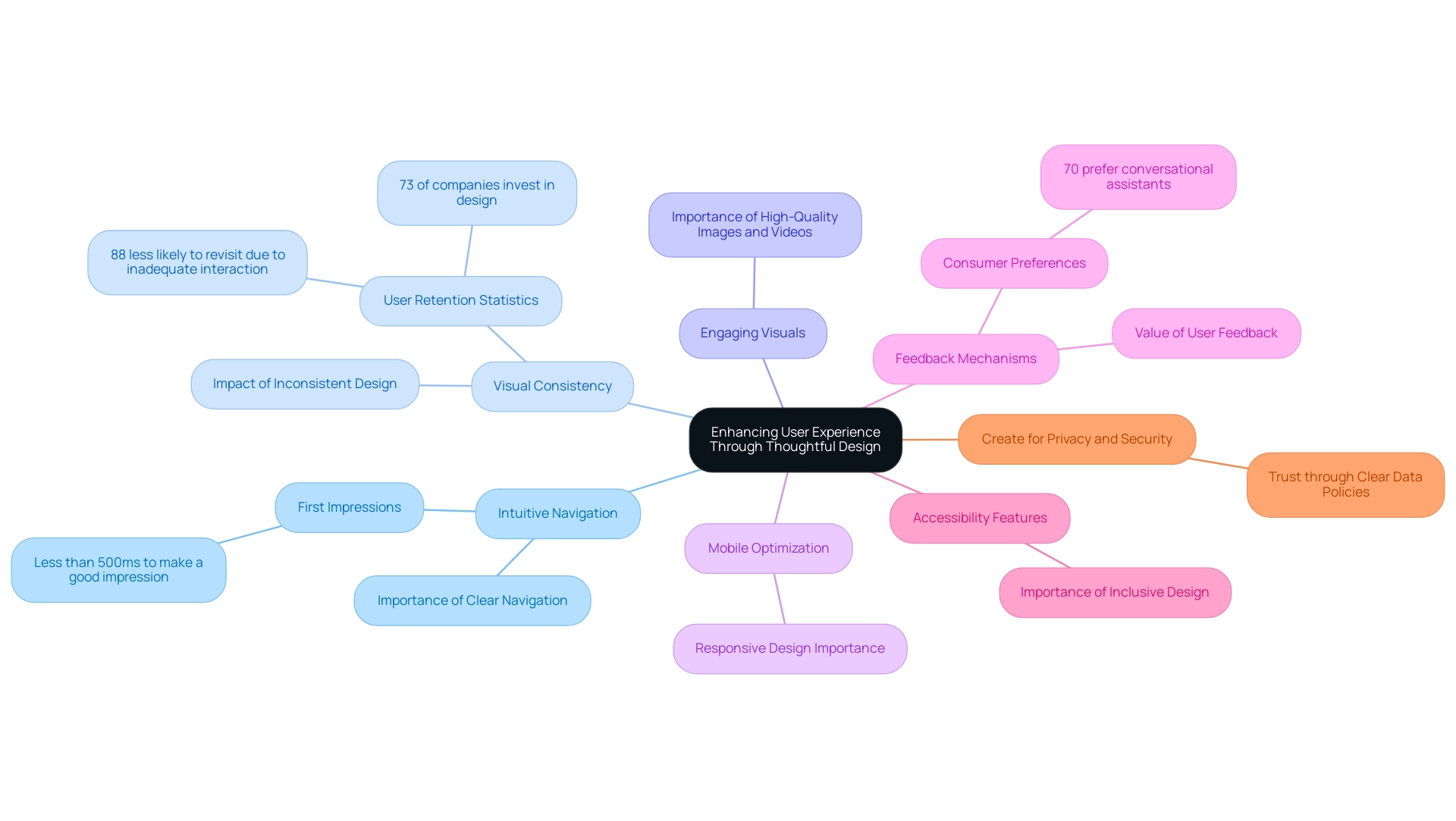
The Role of Content in Effective Web Design
The effectiveness of web design is fundamentally rooted in , which plays a crucial role in to how websites are designed.
- : It is vital to write clear, engaging, and concise copy that effectively communicates your message.
Avoiding jargon and overly complex language ensures that individuals can easily comprehend the information presented. - Strong Headlines: ; they capture attention and encourage individuals to delve deeper into your content.
Headlines should not only be informative but also relevant to the reader's needs. Recent studies indicate that 69% of marketers view content as superior to traditional methods such as direct mail and PR. - Visual Storytelling: Utilizing visuals that narrate a story can significantly enhance the experience.
Incorporating infographics, videos, and images supports your text and aids in comprehension. Notably, has surged, with 92% of marketers affirming that , according to Wyzowl.
The most effective types of videos produced by businesses include product demonstrations, educational content, live events, and webinars. A recent case study highlights the increasing focus on video testimonials and explainer videos as tools for customer engagement, reflecting the growing trend towards video content. Furthermore, TikTok's advertising revenue reached $4 billion in 2022, with expectations to double by 2024, emphasizing the rising importance of video in digital marketing strategies. - : Strategically placing CTAs throughout your site is fundamental in guiding visitors towards desired actions, such as signing up for newsletters or making purchases.
Effective placement of CTAs can significantly influence engagement.
Research indicates that 86% of social media marketers believe establishing an active online community is essential for a successful strategy in 2024, underscoring the importance of encouraging interaction through well-placed CTAs. - Regular Updates: not only keeps it fresh and relevant but also improves search engine optimization (SEO).
A dynamic website illustrates how websites are designed to encourage visitors to return for new information and maintain their interest over time.
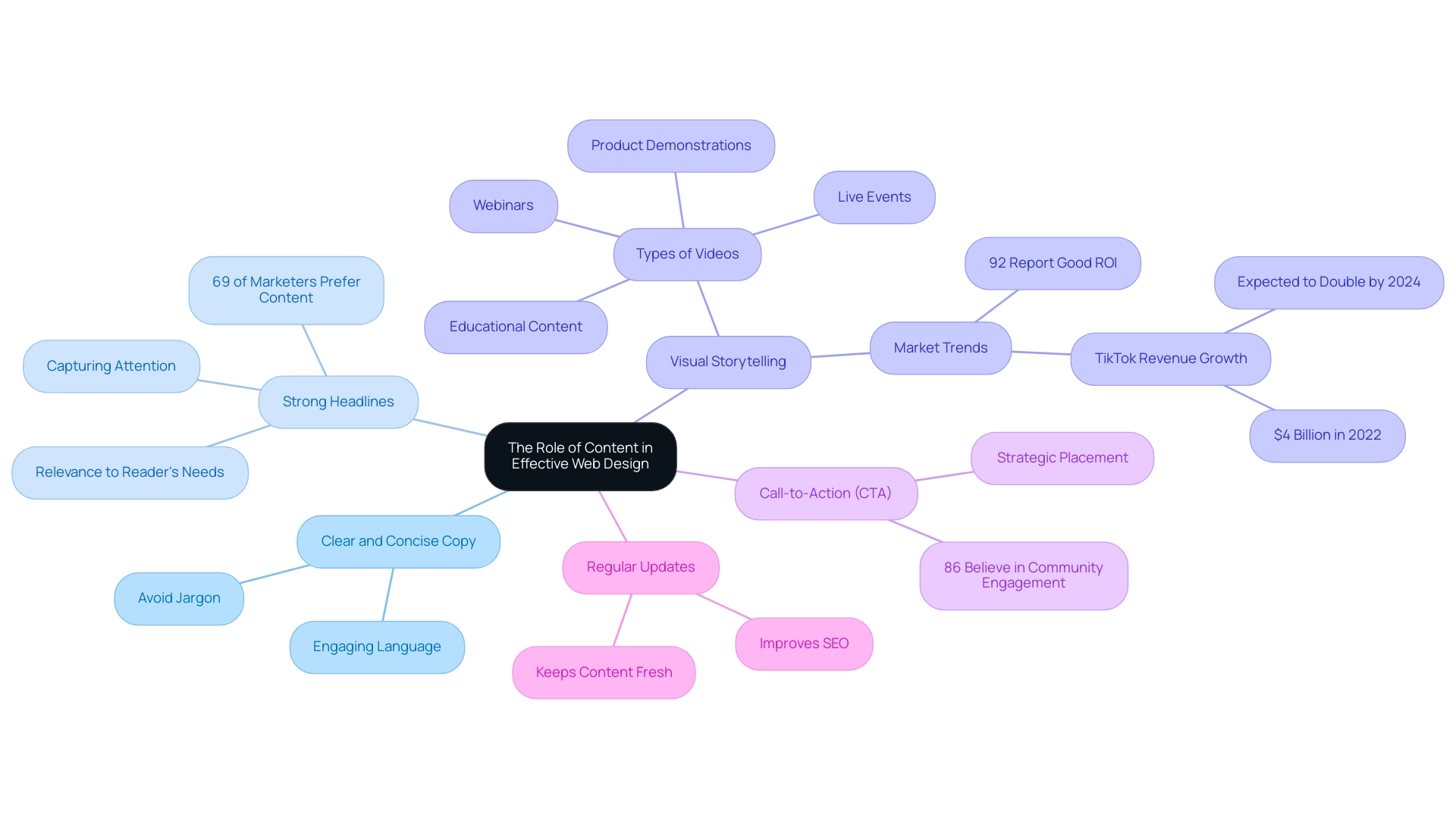
Current Trends and Innovations in Web Design
To maintain relevance in the ever-evolving landscape of web creation, it is imperative to consider several key trends for 2024:
- Minimalist Design: Embracing a by focusing on essential elements, thereby reducing clutter. This approach not only enhances experience but also aligns with to reflect current preferences for simplicity and clarity. As pointed out by industry expert Maria Harutyunyan, finding to drive organic traffic and sales can be influenced by how websites are designed, as a well-executed minimalist layout can significantly contribute to this objective by improving site performance and engagement, which is crucial for driving organic traffic.
- Dark Mode: The integration of , particularly among individuals accessing websites in low-light settings. This design feature not only elevates the aesthetic appeal but also enhances comfort, making it a modern necessity in how websites are designed.
- Micro-Interactions: The use of subtle animations and micro-interactions can significantly enhance engagement. These elements guide users through various actions and provide immediate feedback, showcasing how websites are designed to create a more interactive and enjoyable browsing experience.
- Voice User Interface (VUI): With the rise of , optimizing your platform for voice interactions is becoming essential. Catering to this trend will ensure that your site remains accessible and user-friendly, which is crucial for understanding how websites are designed in a voice-driven digital landscape.
- Sustainability in Creation: Emphasizing but also appeals to a growing demographic of eco-conscious consumers. This can involve optimizing how websites are designed to improve speed and efficiency, thereby reducing energy consumption and promoting eco-friendly hosting solutions.
The , valued at approximately $11 billion, sees over 70% of companies investing in these innovations to gain a competitive edge. For instance, the are leveraging these trends to enhance their clients' online presence, demonstrating the tangible benefits of how websites are designed in modern web design practices. Staying abreast of these trends is crucial for tech startups aiming to enhance user experience and sustain growth in a dynamic market.
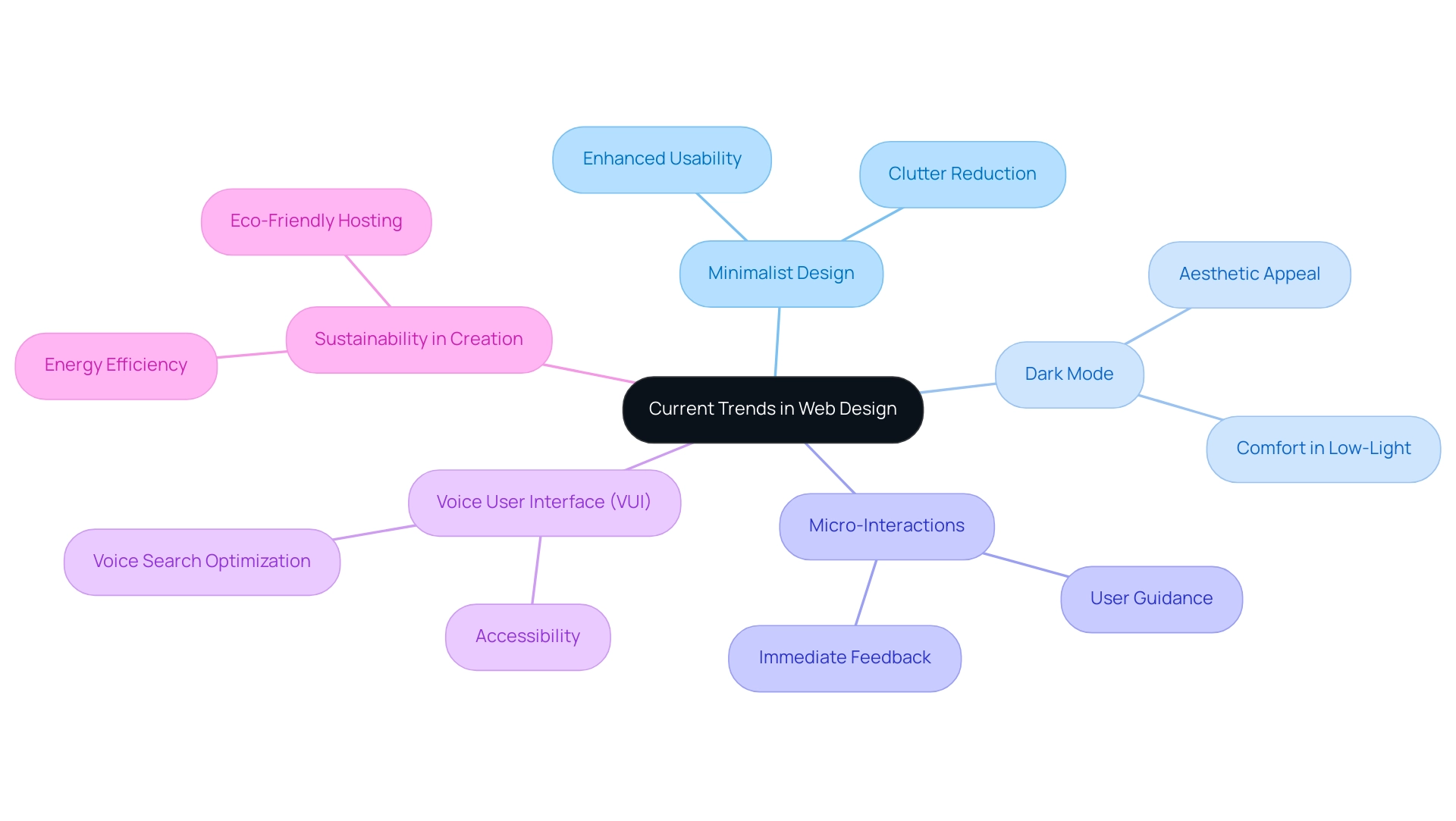
Conclusion
Effective web design is a multifaceted discipline that plays a pivotal role in shaping user experience and driving business success. By focusing on fundamental principles such as:
- Visual hierarchy
- Consistency
- Responsive design
- Accessibility
- Load time optimization
organizations can create websites that not only attract but also retain users. Each principle contributes to a seamless user journey, reinforcing the importance of strategic design in a competitive digital landscape.
Implementing step-by-step strategies—from defining goals and researching the audience to optimizing for SEO and conducting thorough testing—ensures that websites meet user expectations and business objectives. A systematic approach allows for thoughtful design that enhances user engagement and satisfaction, ultimately leading to improved conversion rates.
The importance of content cannot be overstated. Clear copy, strong headlines, and engaging visuals work together to create an informative and compelling user experience. By incorporating effective calls-to-action and regularly updating content, businesses can maintain relevance and encourage user interaction.
As web design continues to evolve, staying informed about current trends—such as minimalist design, dark mode, and sustainability—will be essential for organizations seeking to thrive. Embracing these innovations not only enhances user experience but also aligns with the growing expectations of today’s consumers.
In summary, effective web design is a strategic endeavor that combines aesthetics, functionality, and user-centric principles. By prioritizing these elements, businesses can create impactful online experiences that resonate with users and drive long-term success in an ever-changing digital environment.
Frequently Asked Questions
What are the fundamental principles of effective web design?
The fundamental principles of effective web design include Visual Hierarchy, Consistency, Responsive Design, Accessibility, and Load Time Optimization.
What is Visual Hierarchy in web design?
Visual Hierarchy involves arranging elements to direct attention to the most critical information first, using size, color, and spacing to enhance comprehension and engagement.
Why is Consistency important in web design?
Consistency fosters familiarity and trust among visitors by maintaining uniform design elements like fonts, colors, and button styles across all pages, ensuring intuitive navigation.
What does Responsive Design entail?
Responsive Design ensures that a website operates seamlessly across various devices, such as desktops, tablets, and smartphones, which is crucial for retaining visitors.
How does Accessibility impact web design?
Accessibility involves designing websites inclusively so that everyone, including individuals with disabilities, can navigate effectively. This broadens the audience and increases user satisfaction.
What role does Load Time Optimization play in web design?
Load Time Optimization enhances user experience by ensuring fast-loading pages, which reduces bounce rates. Techniques include optimizing images and minimizing code.
Can you provide an example of successful web design principles in action?
An example is the Orah homepage optimization project, which focused on simplifying navigation and enhancing the visibility of testimonials, resulting in a 63.27% increase in demo request clicks.
What is the significance of understanding web design principles in today's market?
With the web creation market reaching $42.2 billion in 2023, understanding these web design principles is essential for tech startups to remain competitive and meet user expectations.




